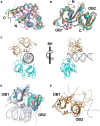Activation and Immune Regulation Mechanisms of PYHIN Family During Microbial Infection
- PMID: 35145495
- PMCID: PMC8822057
- DOI: 10.3389/fmicb.2021.809412
Activation and Immune Regulation Mechanisms of PYHIN Family During Microbial Infection
Abstract
The innate immune system defenses against pathogen infections via patten-recognition receptors (PRRs). PRRs initiate immune responses by recognizing pathogen-associated molecular patterns (PAMPs), including peptidoglycan, lipopolysaccharide, and nucleic acids. Several nucleic acid sensors or families have been identified, such as RIG-I-like receptors (RLRs), Toll-like receptors (TLRs), cyclic GMP-AMP synthase (cGAS), and PYHIN family receptors. In recent years, the PYHIN family cytosolic DNA receptors have increased attention because of their important roles in initiating innate immune responses. The family members in humans include Absent in melanoma 2 (AIM2), IFN-γ inducible protein 16 (IFI16), interferon-inducible protein X (IFIX), and myeloid cell nuclear differentiation antigen (MNDA). The PYHIN family members are also identified in mice, including AIM2, p202, p203, p204, and p205. Herein, we summarize recent advances in understanding the activation and immune regulation mechanisms of the PYHIN family during microbial infection. Furthermore, structural characterizations of AIM2, IFI16, p202, and p204 provide more accurate insights into the signaling mechanisms of PYHIN family receptors. Overall, the molecular details will facilitate the development of reagents to defense against viral infections.
Keywords: AIM2; IFI16; PAMP; PRR; PYHIN family; innate immunity; p202; p204.
Copyright © 2022 Fan, Jiao and Jin.
Conflict of interest statement
The authors declare that the research was conducted in the absence of any commercial or financial relationships that could be construed as a potential conflict of interest.
Figures



Similar articles
-
The emerging role of human PYHIN proteins in innate immunity: implications for health and disease.Biochem Pharmacol. 2014 Dec 1;92(3):405-14. doi: 10.1016/j.bcp.2014.08.031. Epub 2014 Sep 6. Biochem Pharmacol. 2014. PMID: 25199457
-
Mechanisms and pathways of innate immune activation and regulation in health and cancer.Hum Vaccin Immunother. 2014;10(11):3270-85. doi: 10.4161/21645515.2014.979640. Hum Vaccin Immunother. 2014. PMID: 25625930 Free PMC article. Review.
-
Nuclear PYHIN proteins target the host transcription factor Sp1 thereby restricting HIV-1 in human macrophages and CD4+ T cells.PLoS Pathog. 2020 Aug 6;16(8):e1008752. doi: 10.1371/journal.ppat.1008752. eCollection 2020 Aug. PLoS Pathog. 2020. PMID: 32760121 Free PMC article.
-
The molecular mechanisms of signaling by cooperative assembly formation in innate immunity pathways.Mol Immunol. 2017 Jun;86:23-37. doi: 10.1016/j.molimm.2017.02.012. Epub 2017 Feb 27. Mol Immunol. 2017. PMID: 28249680 Review.
-
Nature of selection varies on different domains of IFI16-like PYHIN genes in ruminants.BMC Evol Biol. 2019 Jan 17;19(1):26. doi: 10.1186/s12862-018-1334-7. BMC Evol Biol. 2019. PMID: 30654734 Free PMC article.
Cited by
-
Role of inflammasomes and neuroinflammation in epilepsy.Immunol Rev. 2025 Jan;329(1):e13421. doi: 10.1111/imr.13421. Epub 2024 Nov 10. Immunol Rev. 2025. PMID: 39523682 Free PMC article. Review.
-
Cellular resistance to an oncolytic virus is driven by chronic activation of innate immunity.iScience. 2022 Dec 7;26(1):105749. doi: 10.1016/j.isci.2022.105749. eCollection 2023 Jan 20. iScience. 2022. PMID: 36590165 Free PMC article.
-
Innate Immune Response to Viral Infection.Adv Exp Med Biol. 2025;1476:199-224. doi: 10.1007/978-3-031-85340-1_8. Adv Exp Med Biol. 2025. PMID: 40622544 Review.
-
A cytomegalovirus inflammasome inhibitor reduces proinflammatory cytokine release and pyroptosis.Nat Commun. 2024 Jan 26;15(1):786. doi: 10.1038/s41467-024-45151-z. Nat Commun. 2024. PMID: 38278864 Free PMC article.
-
African swine fever virus structural protein p17 inhibits IRF3 activation by recruiting host protein PR65A and inducing apoptotic degradation of STING.Front Microbiol. 2024 Jun 18;15:1428233. doi: 10.3389/fmicb.2024.1428233. eCollection 2024. Front Microbiol. 2024. PMID: 38957619 Free PMC article.
References
Publication types
LinkOut - more resources
Full Text Sources

